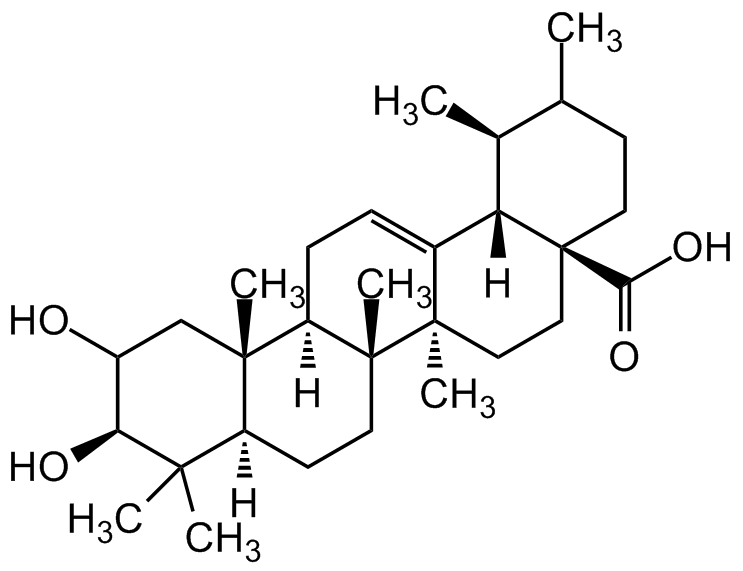Corosolic acid
| Code | Size | Price |
|---|
| CDX-C0704-M010 | 10 mg | £145.00 |
Quantity:
| CDX-C0704-M050 | 50 mg | £547.00 |
Quantity:
Prices exclude any Taxes / VAT
Overview
Host Type: Plant
Regulatory Status: RUO
Shipping:
AMBIENT
Storage:
Short Term: +20°C, Long Term: +4°C
Images
Documents
Further Information
Alternate Names/Synonyms:
(2alpha,3beta)-2,3-Dihydroxyurs-12-en-28-oic acid; 2alpha-Hydroxyursolic acid; Colosolic acid; Corsolic acid; Glucosol
Appearance:
White to off-white powder.
CAS:
4547-24-4
EClass:
32160000
Form (Short):
liquid
Handling Advice:
Protect from light and moisture.
InChi:
InChI=1S/C30H48O4/c1-17-10-13-30(25(33)34)15-14-28(6)19(23(30)18(17)2)8-9-22-27(5)16-20(31)24(32)26(3,4)21(27)11-12-29(22,28)7/h8,17-18,20-24,31-32H,9-16H2,1-7H3,(H,33,34)/t17?,18-,20?,21-,22+,23-,24-,27-,28+,29+,30-/m0/s1
InChiKey:
HFGSQOYIOKBQOW-LNGPDNCPSA-N
Long Description:
Chemical. CAS: 4547-24-4. Formula: C30H48O4. MW: 472.70. Corosolic acid is a triterpene phytochemical found in medicinal herbal extracts. It possesses antiatherosclerotic, antihyperlipidemic/antidiabetic, antioxidant, anti-inflammatory, antifungal, antiviral and antitumor activities. It is an apoptotic agent that induces caspase-8, -9 and -3 activation and shows antiproliferative effects against cancer cell lines. It stimulates glucose uptake via enhancing insulin receptor phosphorylation and ameliorates obesity in vivo. It has been shown to exhibit antiangiogenic and antilymphangiogenic effects in vitro and in vivo. Has also been shown to inhibit mitochondrial fission and NOX2 expression preventing NLRP3 inflammasome activation. It inhibits adipose tissue inflammation and ameliorate insulin resistance via AMPK activation and is an alpha-glucosidase inhibitor.
MDL:
MFCD06794973
Molecular Formula:
C30H48O4
Molecular Weight:
472.7
Package Type:
Vial
Product Description:
Corosolic acid is a triterpene phytochemical found in medicinal herbal extracts. It possesses antiatherosclerotic, antihyperlipidemic/antidiabetic, antioxidant, anti-inflammatory, antifungal, antiviral and antitumor activities. It is an apoptotic agent that induces caspase-8, -9 and -3 activation and shows antiproliferative effects against cancer cell lines. It stimulates glucose uptake via enhancing insulin receptor phosphorylation and ameliorates obesity in vivo. It has been shown to exhibit antiangiogenic and antilymphangiogenic effects in vitro and in vivo. Has also been shown to inhibit mitochondrial fission and NOX2 expression preventing NLRP3 inflammasome activation. It inhibits adipose tissue inflammation and ameliorate insulin resistance via AMPK activation and is an alpha-glucosidase inhibitor.
Purity:
>98% (HPLC)
SMILES:
CC1CC[C@]2(C(O)=O)CC[C@@]3(C)[C@]4(C)CC[C@@]5([H])C(C)(C)[C@@H](O)C(O)C[C@]5(C)[C@@]4([H])CC=C3[C@]2([H])[C@H]1C
Solubility Chemicals:
Soluble in DMSO (10mg/ml) or methanol (1 mg/ml).
Source / Host:
Plant
Transportation:
Non-hazardous
UNSPSC Category:
Natural Products/Extracts
UNSPSC Number:
12352200
Use & Stability:
Stable for at least 2 years after receipt when stored at +4°C.
References
(1) K.S Ahn, et al.; Planta Med. 64, 468 (1998) | (2) T. Miura, et al.; Biol. Pharm. Bull. 29, 585 (2006) | (3) L. Shi, et al.; Eur. J. Pharmacol. 584, 21 (2008) | (4) K. Yamada, et al.; Biol. Pharm. Bull. 31, 651 (2008) | (5) Y. Xu, et al.; Cancer Lett. 284, 229 (2009) | (6) H. Horlad, et al.; Mol. Nutr. Food Res. 57, 1046 (2013) | (7) K.H. Yoo, et al.; Phytother. Res. 29, 714 (2015) | (8) S.J. Kim, et al.; BMB Rep. 49, 276 (2016) | (9) Y. Li, et al.; Antioxid. Redox Signal. 24, 893 (2016) | (10) J. Yang, et al.; Phytomedicine 23, 181 (2016) | (11) M. Ni, et al.; J. Sci. Food Agric. 99, 5881 (2019)



